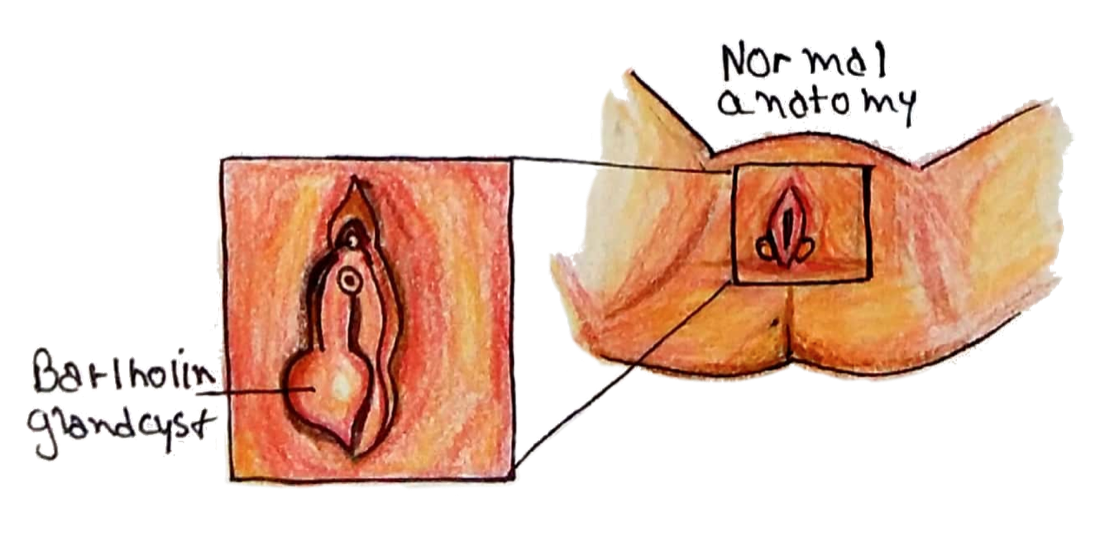Bartholin’s abscess
This is an abscess which forms on the Bartholin’s glands which line the vagina.
– It arises when one of the ducts carrying fluid from the gland gets blocked, giving a fluid filled lump (cyst)
– The cysts can then become infected by bacteria leading to the formation of a Bartholin’s abscess.

Symptoms:
– Vaginal pain and redness
– Unilateral swelling near the vaginal introitus
Diagnosis:
Clinical Diagnosis
Management:
– 1st line is antibiotics.
– If abscess does not respond/is painful, cyst drainage is performed (using word catheter or marsupialization)
Vulval Carcinoma
This describes a rare type of carcinoma which affects part or all of the vulva, usually the outer labia
– Most are squamous cell carcinomas that can be preceded by vulvar intraepithelial neoplasia (VIN)
– It is linked to human papillomavirus infection and so prevented by the HPV vaccine
Risk factors:
– HPV infection, lichen sclerosus and immunosuppression
Symptoms:
– Mostly seen in elderly women
– Vulval lump, ulceration or bleeding
– Features suggestive of cancer –> an irregular fungating mass, irregular ulcer, or enlarged groin nodes
Diagnosis:
– Physical examination and tissue biopsy
Management:
– Surgical resection (+ radiotherapy/chemotherapy).
N.B. NICE(1) say 2-week referral for women with an unexplained vulval lump, ulceration or bleeding
Atrophic Vaginitis
This refers to inflammation of the vagina due to thinning of the tissue caused by low oestrogen levels
– It typically occurs in 50% women after menopause, where low oestrogen causes atrophy of the vagina
– This leads to dryness and itchiness and can lead to more frequent urinary tract infections.
Causes:
– Menopause (almost always), breastfeeding and due to anti-oestrogen medication
Symptoms:
– Vaginal dryness, burning or itching
– Superficial dyspareunia
– Spotting or postcoital bleeding (any postmenopausal bleeding needs checking for endometrial cancer)
– Increased urge to urinate or burning sensation during urination, recurrent UTIs
– On examination -> thin, red vaginal mucosa, dryness, petechia
Management:
– Initially vaginal lubricants and moisturisers, but the best treatment is topical oestrogen gel
Female Genital Mutilation (FGM)
The WHO1 defines FGM as “the partial or total removal of external female genitalia or other injury to the female genital organs for non-medical reasons”.
– It is practiced in West, East and North-East areas of Africa and some places in the Middle-East and Asia
The WHO1 classifies it into 4 types:
Type 1:
Partial or total removal of the clitoral glans and/or the prepuce/hood
Type 2:
Partial or total removal of the clitoris and labia minora +/- removal of the labia majora
Type 3:
Infibulation: the narrowing of the vaginal opening through the creation of a covering seal.
– This is formed by cutting and repositioning the labia minor or majora, sometimes through stitching.
– It may be with or without removal of the clitoral glans and hood/prepuce.
Type 4:
All other harmful procedures to the female genitalia for non-medical purposes (e.g. pricking, piercing, incising)

Complications:
– Pain, bleeding, infection and scar tissue formation
– Vaginal problems –> discharge, pruritis, infections
– Menstrual problems –> dysmenorrhoea
– Sexual problems –> dyspareunia, reduced satisfaction
– Urinary problems -> dysuria, UTIs
– Childbirth complications
– Psychological problems -> depression, anxiety, PTSD

